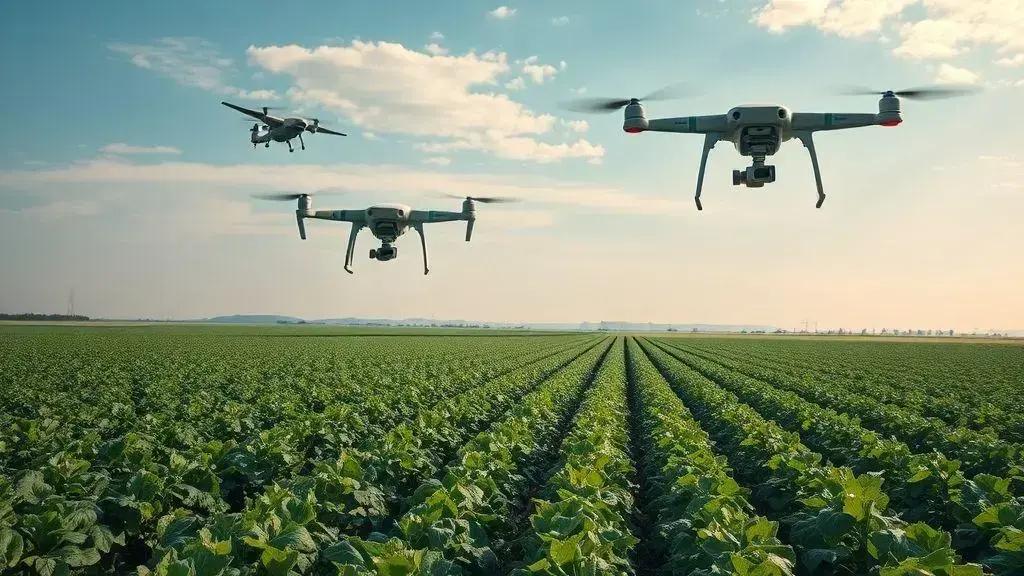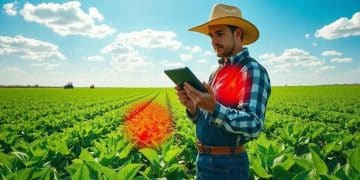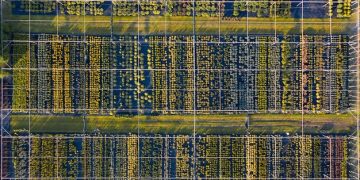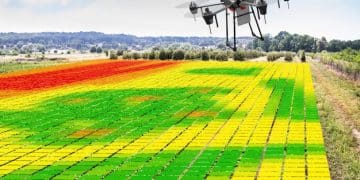AI-driven crop health monitoring: a game changer

AI-driven crop health monitoring utilizes advanced technologies like drones and machine learning to provide real-time insights, enhancing productivity and sustainability in agriculture.
AI-driven crop health monitoring is changing the way farmers approach their fields. Have you ever wondered how technology can make a difference in farming? Let’s dive into the possibilities this innovation brings to agriculture.
Understanding AI-driven crop health monitoring
Understanding AI-driven crop health monitoring is essential for modern agriculture. This technology uses various sensors and data analytics to help farmers assess the condition of their crops. By leveraging artificial intelligence, farmers can receive timely insights that improve decision-making.
One of the key components of this monitoring system is the use of drones. Drones can cover large areas of farmland quickly, collecting data that reveals how crops are performing. This method is much faster compared to traditional scouting methods, allowing for faster reactions to potential issues.
The Role of Sensors
Sensors play a vital role in gathering real-time data. They can measure soil moisture, nutrient levels, and other environmental factors that affect crop health. By integrating data from different sensors, farmers can create a comprehensive picture of their fields. This also assists in identifying specific areas that may need attention.
- Soil Health: Sensors help track soil quality and moisture.
- Pest Detection: AI systems analyze patterns to detect pest outbreaks early.
- Weather Tracking: Collecting weather data helps in planning irrigation and planting.
- Yield Prediction: AI can predict potential yields based on current crop conditions.
Farmers can also utilize machine learning algorithms that analyze historical data. By examining past crop performance data and correlating it with current measurements, AI can predict future problems and suggest solutions. This knowledge can save time and resources while maximizing the yield.
Moreover, as technology advances, the ability to analyze data will only get better. Understanding AI-driven crop health monitoring means being prepared for future advancements that will continue to enhance agricultural practices. It connects farmers with technology, making agriculture more efficient and sustainable.
Benefits of AI in crop health assessment

The benefits of AI in crop health assessment are numerous and impactful. By utilizing artificial intelligence, farmers can enhance their efficiency and productivity. This approach not only saves time but also provides precise data for informed decision-making.
AI systems can analyze large amounts of data quickly. For instance, farmers can receive immediate feedback on crop health. This immediate response allows them to make adjustments such as changing nutrient levels or applying pesticides more effectively.
Efficiency in Monitoring
With AI, the monitoring process becomes much more streamlined. Farmers can use drones equipped with cameras to survey fields regularly. These drones collect data on plant health, identifying areas that may need attention. The result? Less guesswork and more targeted action.
- Real-time data: Farmers can access up-to-date information about their crops.
- Precision farming: AI helps in applying resources only where needed.
- Cost savings: Overall operational costs can be reduced through efficient resource management.
- Yield improvement: Better insights lead to increased productivity and harvest quality.
Additionally, AI can predict issues before they escalate. By analyzing patterns and historical data, AI tools can alert farmers of potential diseases or nutrient deficiencies. This preemptive approach helps to maintain healthy crops without excessive resource usage.
Moreover, as technology continues to advance, the integration of AI in agriculture will yield even more benefits. Future innovations may include more sophisticated sensors and analytics tools. Understanding the benefits of AI in crop health assessment positions farmers to take advantage of these advancements as they emerge.
Implementing AI technologies in agriculture
Implementing AI technologies in agriculture is transforming how farms operate. Farmers can now gather intelligent insights that help improve productivity and sustainability. These technologies offer tailored solutions for various farming challenges.
To start, farmers must identify the specific areas where AI can make a difference. For instance, some may focus on precision agriculture, which uses AI to ensure that crops receive optimal conditions. This strategy leads to better yields and resource management.
Steps to Implement AI
Getting started with AI technologies involves a few essential steps. First, it is crucial to understand the types of data that can be collected. Data can include weather patterns, soil health information, and crop performance metrics. Once this data is gathered, farmers can analyze it to make informed decisions.
- Choose the right tools: Select AI software or platforms that align with farm goals.
- Train staff: Ensure that workers understand how to use AI tools effectively.
- Monitor results: Regularly check the impact of AI on crop yields and resource usage.
- Adapt and refine: Stay flexible to adjust strategies based on AI insights.
Additionally, many farmers are using drones and IoT devices to collect data. Drones can assess crop health from above, providing detailed imagery for analysis. IoT devices can monitor soil moisture levels in real-time, ensuring optimal irrigation practices.
Throughout the process of implementing AI technologies in agriculture, collaboration is key. Farmers can join networks or cooperatives to share best practices and experiences related to AI applications. By working together, they can learn from successes and setbacks, speeding up the adoption of these high-tech solutions.
Future trends in crop health monitoring

Future trends in crop health monitoring are set to revolutionize agriculture even further. As technology advances, farmers will have access to even more sophisticated tools that can analyze crop conditions with greater accuracy. These innovations will lead to enhanced decision-making and better resource management.
For example, we can expect more integration of machine learning and deep learning techniques. These algorithms will refine data analysis, allowing for more precise predictions about crop health. By learning from vast sets of data, AI can identify patterns that humans might overlook.
Emerging Technologies
Another significant trend is the use of satellite imagery combined with AI analytics. This method provides a broader view of agricultural lands and can help detect issues on a larger scale. Farmers will be able to monitor crop health from space, gaining insights that can cover multiple fields at once.
- Remote sensing: This technology continues to improve, enabling better assessment of crop stress.
- Predictive analytics: Farmers will anticipate outdoor conditions and plan accordingly using advanced models.
- Automation: Automated machinery will integrate AI to perform tasks like planting or spraying based on real-time data.
- Blockchain technology: It may track data integrity and enhance transparency in agricultural practices.
As these technologies evolve, they will not only improve productivity but also promote sustainability. Farmers can expect tools that optimize resource use, reducing waste and environmental impact. The focus on sustainable practices will gain urgency in the face of climate change and population growth.
Moreover, community collaboration will play a vital role in adopting these trends. Farmers can share insights and experiences to help each other adapt to new technologies. By working together, they can embrace the future of crop health monitoring more effectively, ensuring that agriculture continues to thrive in a changing world.
FAQ – Frequently Asked Questions about AI-driven Crop Health Monitoring
What are the main benefits of AI in crop health monitoring?
AI enhances productivity, provides real-time data, and allows for more sustainable farming practices.
How can farmers implement AI technologies effectively?
Farmers should identify their needs, choose the right tools, train their staff, and monitor results regularly.
What role do drones play in crop health monitoring?
Drones collect data from above, providing detailed imagery and insights into crop health and potential issues.
How will AI technologies impact future agriculture?
AI will improve efficiency, increase yields, and promote sustainable practices, ensuring farmers can meet future challenges.





